-
2017-04-14, 12:22 PM #81
-
2017-04-14, 12:56 PM #82
In the abstract you're not incorrect. But in our specific case, you're miserably incorrect in one specific way: the amount the US pays on healthcare (and to a lesser degree Social Security) is an abomination. The services offered cost what they do... here... and no where else. And they're not better. They're just expensive. The amount we spend on healthcare is not an intrinsic good because, basically, taxpayers are getting incredibly ripped off.
This country has tried indirect methods at "flattening the curve" of healthcare growth costs or distributing the costs, or modestly stimulating market forces in a tryhard attempt to keep costs down. It's all largely failed. The costs are enormous, and we've seemingly accepted paying as much as we do.
It comes down to this: do you believe in healthcare at any cost? I absolutely do not. I see Medicare specifically growing by tens of billions per year and I see something that must be stopped, and then reversed. Not because I want to cut healthcare provided, but because accepting that we spend at that rate is unacceptable. The joke about United Airlines used to be that they were a Pension Plan that just happened to fly planes. Keep this up, the US will be a healthcare system that just happens to have a military and a few other things.
Japan's the model of course. Or Singapore. The US is just not serious about it's healthcare issue.
These "excursions" have been largely side-stories. THe bulk of US military spending goes to warding off conventional military threats. In that regard, it's been enormously successful. To put it another way, we don't spend $600 billion a year for Iraq, for Afghanistan, for ISIS. That's just something the military does. We spend $600 billion a year to make sure that Russia stays mostly in its cage, China stays mostly in its cage, and Iran stays mostly in its cage.
Or to put it another way, the US Grand Strategy, officially, is to make sure there arises no hegemonic power in Eurasia. Most US trade is in Eurasia. Most of the world's population is in Asia. Most US international interests are in Eurisia. Were a hegemonic power to arise, and manage to push the US across the oceans, the ability for the US to advance it's global interests would be essentially wiped out. We'd be a backwater at the mercey of a trans-continental hegemon.
Before you say "oh Skroe, that's crazy"... that's happened twice in the past century and the third time is building.
The first time it happened was with the Nazis and Japan. In their two spheres of influence, the Axis managed to conquer most of Europe and Asia. Un-broken, they would have in time threatened South and North America.
The second time was with the USSR. Make no mistake about it: the US has never had a decade of strategic defeats like the 1950s. At the start of the decade we were by far the most powerful country in the world. By 1960, we were clearly number two, and the gap was widening. The Communist advance across the world in that decade pushed the US, which was unmolested from World War II to the brink of being isolated from large portions of the world. It took 40 years to reverse that.
The third time, building right now is with China. Make no mistake what their Anti-Air / Area Denial weapons are: an attempt to push the US back eventually, to Hawaii. In the near term, they want to push the US off its shores, and back to Guam, enabling China to make its neighbors subordinate to it. In the longer term, their ambitions extend through the New Silk Road to unite all of Eurasia behind and under China. At our expense. This will have direct ramifications on our quality of life, national security, economic welfare, geopolitical position, and the sustainability of the liberal international order since World War II. China wants to replace that order with one it built. The New Silk Road is its backbone.
Make no mistake about it: ensuring the New Silk Road is strangled in its crib is the most important thing the US can do to it's long term interests. Should it take root, it will take decades, a lot of money and a lot of shitty acts on our part to destroy it. Possibly? Absolutely. We're talking about Asia here. But needless.
Absolutely, but before we begin, fair warning, you're going to be juggling a lot of numbers and graphs. This is the most complex budget in the world that is evidently, audit proof. There is no tl;dr. I wish there were.
The first thing you need to know, is that there are actually TWO defense budgets. There is the "discretionary" Defense base budget... what is commonly called the Defense budget. This is where you would find the army budget, the Navy budget, the Air Force budget and so forth. This is where you'd find the money their bases world wide, for their gasoline, their healthcare... everything of that nature. The Defense Budget is subject to caps under the Budget Control Act however, which is important (you'll see why in a second).
The second budget is called the "Oversees Contingency Operations" budge. This is a euphemism. The OCO budget used to be called the Global War on Terror budget. When Obama was elected, his very clever staff (not really) wanted to get rid of the "War President" stuff that bothered "President Change" (#2 of 3), so War on Terror was replaced with Oversees Contingency Operations in all government documents, despite meaning the same thing.
However there was a purpose shift in the OCO budget over time. For a long time, it paid directly for the Wars in Afghanistan and Iraq. The base budget would pay for having an Army in general, but the OCO budget would pay for the additional operational costs of everything that was needed to keep that Army in Iraq. Over time though it started to become a small bit of a slush fund. Not to bad. A few extra jets here and there. It later got way worse. After the Budget Control Act passed and the Defense Budget was capped, the OCO budget became a pressure valve. It grew and grew. And more than that, the percentage of it grew and grew to the point it became mostly a slush fund. Why? The OCO budget is not subject to Budget Control Act caps.
Why did this happen? Because the Budget Control Act capped the Pentagon's budget at a level well below what the Pentagon had expected - and was promised, it's budget levels would be, which meant that the OCO budget had to fill in the blanks. But simultaneously the OCO budget was ALSO cut by Obama as part of his scheme to "bake" it into the Defense budget... a defense budget with a lower top line. You throw in a lower topline, that's how Obama managed to cut defense spending by about a quarter. May his children damn him for it.
So now that you know what the OCO and the Defense budget are, we can start looking at numbers.
This is the pentagon budget. Probably the one you're looking for the most.
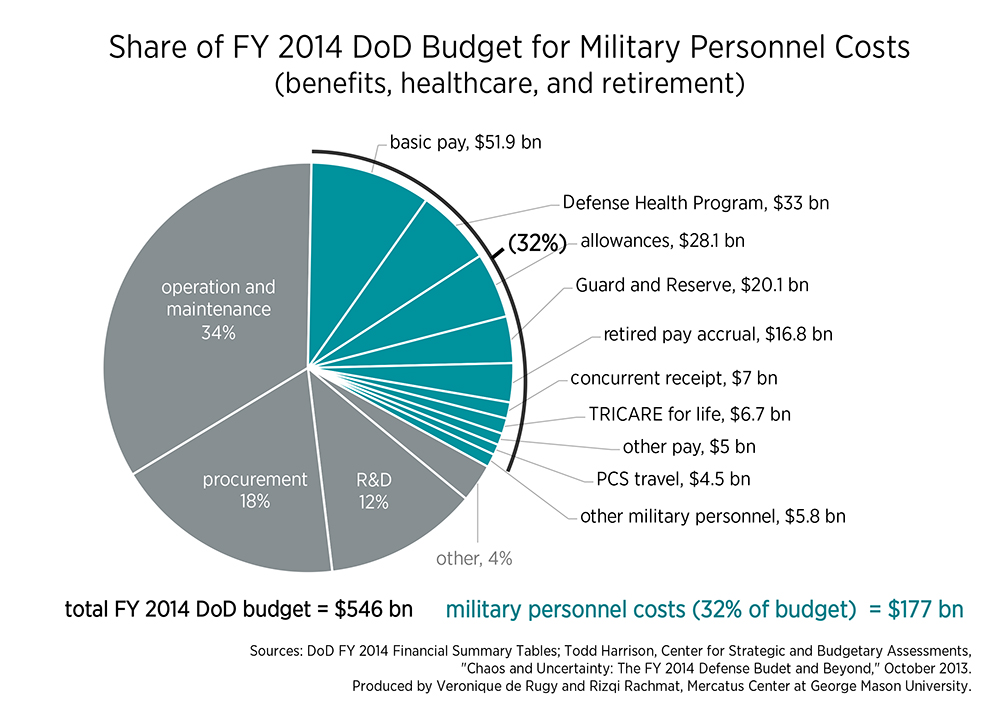
34% of the budget is spent on Operations and Maitenence. This goes from everything to paying for the ongoing US presence in South Korea and Germany, to scheduled US Navy Ballistic Missile Submarine Strategic Detrrence Patrols, to paying for gas for humvees on Fort Hood, to money for repairs to a Destroyer in for scheduled maitnence. Basically the US military's ongoing missions... minus most of the big fighting... just their bread and butter... and keeping everything working.
18% goes into procurement. We'll talk a bit about that. But if you expect most of that to be towards jets or ships... nope. The number one single item on procurement is space launch vehicles from ULA.
12% is R&D. THis is largely what you think, but there is some interesting details here too. We'll get back to that below.
32% however, is Military Personel costs. And that chart breaks it down. And this should not be surprising. For any large organization, human resources are, by far, the largest share of spending. Over the past decade this has grown the most (concurrent with the VA budget). Why? Tricare costs increase without troops having to pay more into their helathcare, pay has gone up well above what it was in the early 2000s. The retired military post-Iraq and Afghanistan has grown. This 32% is far and away the biggest driver of growth of the budget.
Here is a comparison between 2000 and 2014 on this very issue.

As you can see, 46% increase in Military Personel costs between those years. People are expensive.
Here's another way of looking how the first chart (roughly) compares to how things were in 2000, in 2014 dollars.
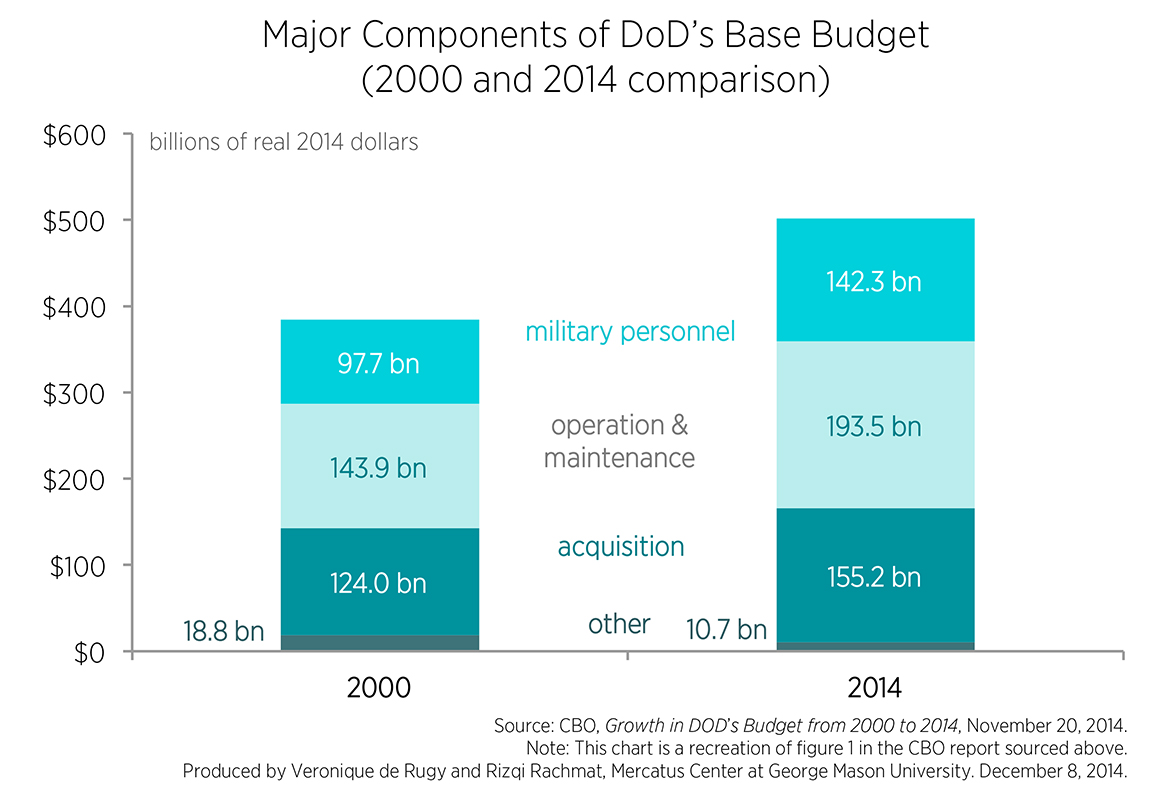
To put it simply, people have gotten much more expensive. The US military is doing modestly more, but it isn't buying a hell of a lot more.
Remember I mentioned the OCO budget, well on a dollar basis, this is how the two budgets break down for 2017, compared to 2016.

(RDT&E = Research Development Test & Evaluation).
This is a few years old, but this is how the older, larger OCO budget went to, and how it compared to the newer, smaller budget, by category. I do want to note: it's become much more slushy since 2015.

And two bonus round graphs that I think are worth looking at to but information in context, but don't really fit in anywhere specifically.
https://i.redd.it/23un7zw1pkmy.png
(huge image)
This is the top 100 US defense contractors. Money for Procurement, R&D, and maintenence would go here. Interesting datapoints: $209B goes to US contractors, but $147 billion goes to international contractors.
Next, let's talk Science and R&D.

The Pentagon spends is $2 billion more than all the rest of US federal science funding combined. You can see the specific breakdowns on the chart. But it's an enormous source of research money. Half my employer's budgeting (but not my program, to be clear) comes from this.
---
It comes down to this: people are expensive. A European NATO Defense Minister put it so beautifully last month, I hope it stands for all time. He said, in response to the "why doesn't your country spend 2% of GDP on defense" issue, that if that was so importance, he could just as Parliament to double troops pay. That'll allow them to hit it instantly.
In flash, that should make clear both how huge personnel costs are on any budget, and the sheer idiocy of the 2% target as symbolic of anything. It's not even symbolic of commitment. Doubling troops pay to hit that target, as he was implying, wouldn't get you a "better" military in the slightest. Just a more expensive one.
I've been saying this for ages, and this 2% stuff is timely. NATO... including the US, could roundly spend LESS on defense than 2%. Probably between 1-1.5%, if they bought smarter. If they did large, multinational programs and shared manpower intensive (and expensive) resources. If they had predictable budgeting.
And that last bit is essential to the US Military. Want to know how the USS Ronald Reagan was a $5.9 billion Aircraft carrier (2017 dollars), but the one being built now, USS John F Kennedy is a $11 billion carrier? It's not contractor greed. Its that when the Reagan was being built, Congress was reliably building one carrier and buying the next two, in annual budgets. This allowed ship builders (and the Pentagon) to buy materials in bulk because their funding was reliable through the construction program. They didn't have to do things like idle standing armies of contractors because Congress didn't fund something yet, which has been the norm since the mid 2000s.
SO basically... you want to spend less on defense? A good first start is to get back to the normal order: have Congress pass a budget, every year, before the next fiscal year starts, and have a 10 year budget plan that is followed to the letter. You know who actually mapped this out, with Obama's support at the time? Secretary of Defense Robert Gates. He knows all of this. The worst thing for contractors is unpredictability. So he wanted to create an environment of budgetary certainty, for a decade.

You know who was lying through his teeth while Gates was doing it? Barack Obama, who never had any intention of submitting budgets that represented the Gates plan he endorsed.
Some people don't like Obama for his liberalism. I don't like Obama because of shit like this. The President is fundamentally the Most Senior Manager of the Executive Branch, and Obama, with putting aside the Gates plan, was being a malignant force intentionally. He knew that predictability was at the very core of fixing defense spending, and he did not care.
-
2017-04-14, 01:10 PM #83
Basically, invading North America is a no-win situation for most of our enemies, because they have neither the troops nor finances to sustain an attack when US-Canada joint operations have a history of being extremely effective to the point that in WWII, such a joint force was named the Devil's Brigade by the Axis. Canada doesn't need the massive, throbbing hardon for defense spending conservatives in the US have (and frankly, we could go without giving that defense-spending hardon a handy once in a while), which I think bewilders conservative US posters on this forum because the US has this weird fetishization of the military where it's almost religious in its zeal.
Be seeing you guys on Bloodsail Buccaneers NA!
-
2017-04-14, 01:23 PM #84
For whatevever reason, when most people in these parts think war they think this:

Let's invade and conquer some territory boys!
No. War in the 21st century is going to mean long range (conventional) ballistic missiles and cruise missiles neutering a country's ability to make war.
Canada's aviation industry in particular is deeply enmeshed with the US defense industrial complex. You think China, Russia or whoever else wouldn't launch long range missiles at a Canadian factory producing aircraft for US forces? It would take years to rebuild a facility, nevermind the lost institutional knowledge which could never recover. Of course they're going to blow it up. And by the way, that's exactly what the US would do to China. Target the factories... cut off their ability to produce more than what they already have.
This is why I said Canada needs to spend it's money on missile defense, long range missiles, air craft and mid-sized naval craft. Because if China or anybody else thinks they can cripple the US defense industry's ability to produce, they'll take that opportunity. A Canadian flag (or any flag) or Tennisance's myopic principles nobody cares about won't protect them.
-
2017-04-14, 03:08 PM #85
-
2017-04-14, 03:16 PM #86
Frankly, I don't mind our high military spending. I do wish we had more tax dollars coming in, and more spending on education, science, health, NASA. It is important that we have a strong military and we are the world's wealthiest nation, and we do have bases across the entire world so we can essenitally be anywhere in short order. We are a great deterrant for many conflicts, and it is important that we be able to destroy those necessary with few cassualities on our side.
-
2017-04-14, 03:28 PM #87
-
2017-04-14, 03:36 PM #88
-
2017-04-15, 03:40 AM #89
I don't disagree that you're not getting bang for your buck on healthcare. But I'd apply the same thing to the military, times ten.
Thanks for the details. Do you also know how many people the personnel costs pay for? What role they fill, where they're deployed etc.
I'm also interested if your personnel budget went up per head or if you're just employing more people (are these figures inflation adjusted by the way?).
Also when you say ULA space vehicles, are we talking satellite launches here? Or is NASA's budget mixed in with this?
- - - Updated - - -
I ask the man for details, he provides.
Whether I agree or disagree with his assessment, I respect his posts. I wish I lived in a world where people on both sides of politics were Skroes, then these boards would be a place for discussion, polite disagreement, and even some actual learning. Instead of monkeys throwing shit at each other while the world gets progressively more covered in monkey shit.
-
2017-04-15, 03:47 AM #90
I believe ULA space vehicles are under the Air forces budget in particular, in terms of how many this pays for: As of 2017 the US army has 460k Active, 530k reserves, who I'm guessing don't get paid? Or would they get certain benefits? /shrug, The US Navy has 323k active and 109k reserve, The US air force has 313k Active and 141k USPFT's 70k reserves and 105k air guard, the US marine corps has 182k active and 39k reserve. That's a total of Roughly 1.3mil active and 810k reserve. In terms of what appropriation looks like the Marines have 1200 aircraft, presumably counting drones and helicopters on top of planes. Air Force has 5000+ planes 406 ICBM and 63 Satellites, the Navy has 274 deployable ships, 430 total ships and 3700+ aircraft, and the Army has 4,836 aircraft and a fuck ton of armor.
-
2017-04-15, 04:07 AM #91Dreadlord


- Join Date
- May 2008
- Location
- Edmonton, AB
- Posts
- 937
I hate myself for saying it, and I feel like I need a shower, but I agree with Skroe on a US healthcare cost. It's an incredibly bloated business, reaching crazy proportions and nothing can stop it now, outside total anarchy, which would destroy Earth civilization as we know it.
-
2017-04-15, 11:28 PM #92
-
2017-04-15, 11:34 PM #93Deleted
-
2017-04-15, 11:40 PM #94The Unstoppable Force


- Join Date
- Mar 2012
- Posts
- 23,787
-
2017-04-15, 11:44 PM #95
Just like China protects North Korea because of border concerns, we will always protect our hat.
And I saw, and behold, a pale horse: and he that sat upon him, his name was Death; and Hades followed with him. And there was given unto them authority over the fourth part of the earth, to kill with sword, and with famine, and with death, and by the wild beasts of the earth.
-
2017-04-15, 11:49 PM #96
-
2017-04-15, 11:50 PM #97
-
2017-04-16, 12:08 AM #98
The military is actually underfunded beleive it or not, by about $100 billion. Maybe as high as $150 billion. We should hit a $1 trillion Pentagon budget within the next decade.
Now you must be thining... "that's nuts... how can anything at the cost of $600 billion be underfunded".
Because looking at the number is the wrong approach. That puts budget infront of requirement. That's backwards. The requirement must DICTATE the budget, and if the requirement is too great, cut the requirement and have a lower budget.
The country charges the military to engage in rather elaborate global operations, some lasting three quarters a century. And it keeps adding on requirements, while not increasing defense spending to keep up.
Let me give you a rock solid example. Forgive me if you've read this one already, but it's really good. The US Navy Chief of Operations was asked by Congress "how many ships would you need to meet 100% of Combatant Commander's requests". He said at least 450 ships.
The US navy has 275 ships. It'll have 355 ships over the next 30 years.
So how does the US navy execute a 450 ship mission by having 275 ships? By increasing risk per mission. For example, the Carrier sent near North Korea was escorted by One cruiser (area air defense) and two destroyers (multipurpose, air defense, surface warfare) and probably an attack submarine. Compared to what a Carrier Strike Group was a decade and a half ago, that's nothing. CSGs once had two cruisers, four to six destroyers, four to six frigates (all since retired early), and two attack submarines. Furthermore today's carriers routinely carry 65 aircraft, whereas they are built for and used to carry 90. The Navy has folded up air wings and retied aircraft to save money.
Now true, today due to advances in technology, two F/A-18E/Fs can do the job of an entire F/A-18C/ squadron 30 years ago. But quantity is a quality all its own. One cruise for example, greatly reduces the defensive layer of a CSG compared to do. However the Navy says to it's boss - civilians - that "we can do the mission, if you accept increased risk".
So what's what we've done. Years of accepting increased risk to save a little money here and there.
This is not an argument to say we need to spend more money because a war boner gives me thrills (if I haven't made it clear by now, I don't care about that at all). It's a direct assault on that principle of "increasing risk to save money". As I see it, if we civilians charge the Military to execute a mission, we owe it to them to fully fund that mission, whatever it may be. If the Navy says "we need 450 ships", we pay for the 450 ships... or we don't charge them to execute a mission that requires 450 ships.
To me, that's responsible. That's how affairs should be run. Rather than stretching money and spreading forces around to do an enormous number of things, we either pay to do the enormous number of things in full, or we do fewer things. In either way, the budget must fit the mission.
So when I say "we need to give the military $100 billion more", it's not because I want the country to fight more wars (quite the contrary). It's because the military has been screaming at the top of its lungs for years that it is stretching itself dangerously thin with what it is being asked to do. It can fix that, quickly, but that takes money.
We must fix it, or we must downsize or goals. That second part is a policy question, set by civilians. I have my opinions of course, but I've been on the losing side of policy before and it's part of life. But the intolerable part, from my perspective, is how we shortchange the missions we lay out for our armed forces.
Okay here goes

So this should put the force size in context over time, the "2014 QDR" refers to the 2014 Qudrennial Defense Review, which is a Pentagon Study every 4 years to reassess military needs/status compared to mission.
The one you want to look at is the "2-MRC Paper", which refers to the "2 Major Regional Contingency" paper, a study as to what it would take to get US forces back to the level they were at until 2009, where they would be capable of fighting two major wars at the same time. The Trump Military Build-Up plan, as well as what Congress has been talking about for a couple of years, along with probably what Clinton would have done, is very close to the 2-MRC plan, with an additional carrier. In one way though the 2-MRC plan is defficient. The Navy's new plan calls for this:

You'll note the huge increase in attack submarines. A larger navy with more ships requires more people, as does a larger Army with more combat brigrades (which have declined by a third in five years).
For comparison, this is whats happened to US Air Power.
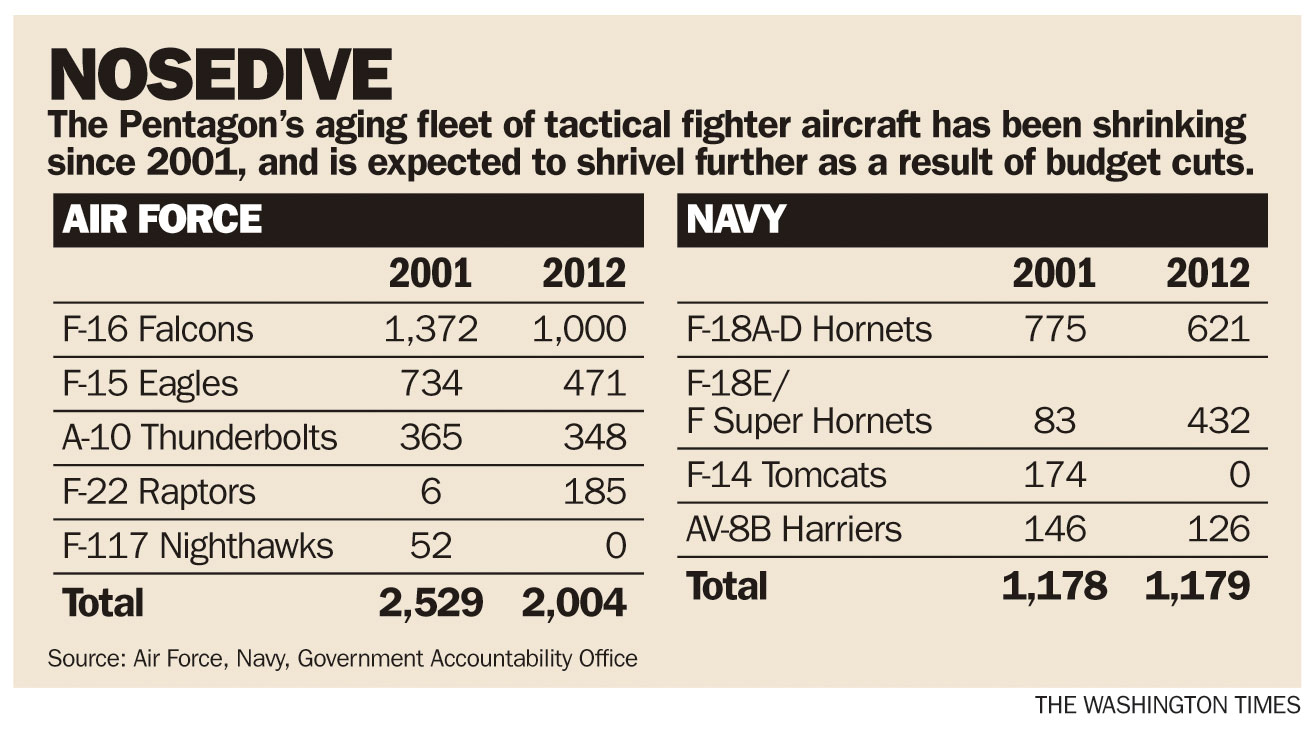
All in all today the numbers are this:

The Army was scheduled to drink to 450,000 by 2017 but Congress put a stop to that recently.

And here's a great breakdown of the ACTUAL per unit costs. Can't believe I found this again..

So you can see how personell costs are enormous. For the army, for example, each Infantry Brigade Combat team is $2.4 billion and we have 14 of them (and that's low).
So that answers the question of "how many" and by type, "what they do". As for more details on the costs, i think this charge illustratres everything:

To explain what you're seeing here, the green area is MILPERS, which is easiest to think of as the financial obligation has from it's "warchest" to every individual service member. It's not just salary. It's equipment, lodging, combat pay, food. Basically what it costs the war chest to "have" 1 service member. And as you can see, the healthcare beast grows and grows and grows.
Oh, and it'll keep growing.

So once again: people are enormously expensive.
Yes sattelite launchers, namely the Atlas V and Delta IV. These two rockets:

They are America's primary space launch vehicles for both military and civilian (NASA) launches and are both built by United Launch Alliance (ULA), a Lockheed Martin / Boeing joint venture.
A little bit of history about how this happened (and why it's expensive).
Until around 1981, the US military relied on first and second generation space launch vehicles, which, like China's today, were mostly built on repurposed ICBM technology. It's funny to think about but in 1981, the Apollo program had wrapped just a decade prior, and when it takes 36-48 months to build a single rocket, we're talking it was very recent from an industrial standpoint.
The Space Shuttle was coming online and needed missions. The only reason the shuttle was approved was because it was argued that a regular flight rate (up to once per week) would make it highly economical compared to disposable launchers. It became very clear though that the Shuttle's thermal protection system wouldn't allow this, and that there just wasn't (at that point), the demand for a space vehicle to travel to space that often. As a result, in order to give the Shuttle more missions, Reagan ordered that all legacy US launchers be retired and the Shuttle become the ONLY US government launch vehicle. This is why if you look at the Shuttle launch history in the mid 1980s, you see missions they generally didn't do later, like take NRO spy sattelites to orbit, or Air Force Weather Sattelites.
Obviously, in retrospect, this is insane... sending 7 people up on a $600 million per-flight launch vehicle just to deploy a sattelite. What really drove that point home though was Challenger. After it blew up the Pentagon decided to divorce itself from the Shuttle as much as possible. Some older legacy launchers were put back into production temporarily, but the "Evolved Expendable Launch Vehicle" program began (EELV), which would be two purpose built launchers that would compete against each other, and eventually in a commercial launch market. There is a lot more history, but over the next 15 years, this resulted in the Atlas V from Boeing and Delta IV from Lockheed.
Both were meant to be direct competitors, but the commercial market didn't develop as expected (the situation is VERY different in 2017), and faced with Boeing or Lockheed exiting the business, decided to authorize the two to form a joint venture - ULA - which produced both. This actually worked out. The Atlas V is America's workhorse and is far cheaper and less complicated than the Delta IV. Although the Atlas V was designed to be bolted together with two other cores to be as large as a Delta IV (i.e. an "Atlas V Heavy") this never happened. The Delta IV Heavy is far more powerful a launcher (over twice as much as an Atlas V), but far more expensive.
"Expensive" being the keyword. Until SpaceX came along, ULA was America's only rocket builder. So it could charge whatever it wanted to to put sattelites into orbit. And it did. It charged an arm and a leg. But that' doesn't even capture how much of a rip off it is:
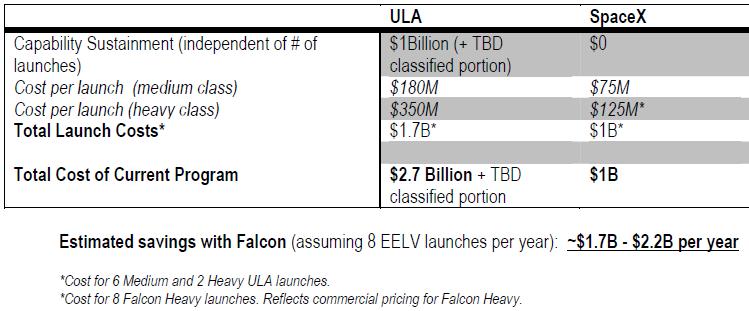

With ULA as the only rocket builder until relatively recently, it just soaked up sole-source contracts from the Air Force (and NASA) for over a decade... a decade that SpaceX spent building reusable and overall superior rocket technology (based on, ironically, technology the Air Force abandoned as part of it's EELV work in the mid 1990s). As a result ULA is at least a decade behind SpaceX in developing competing technology. There is a very real chance that they'll exit the business before then because they cannot make an Atlas V or Delta IV competitive with a Falcon (and the partially reusable Vulcan rocket won't be much more competitive).

So yeah it's a lot of money.
Here is what some of the programs cost:
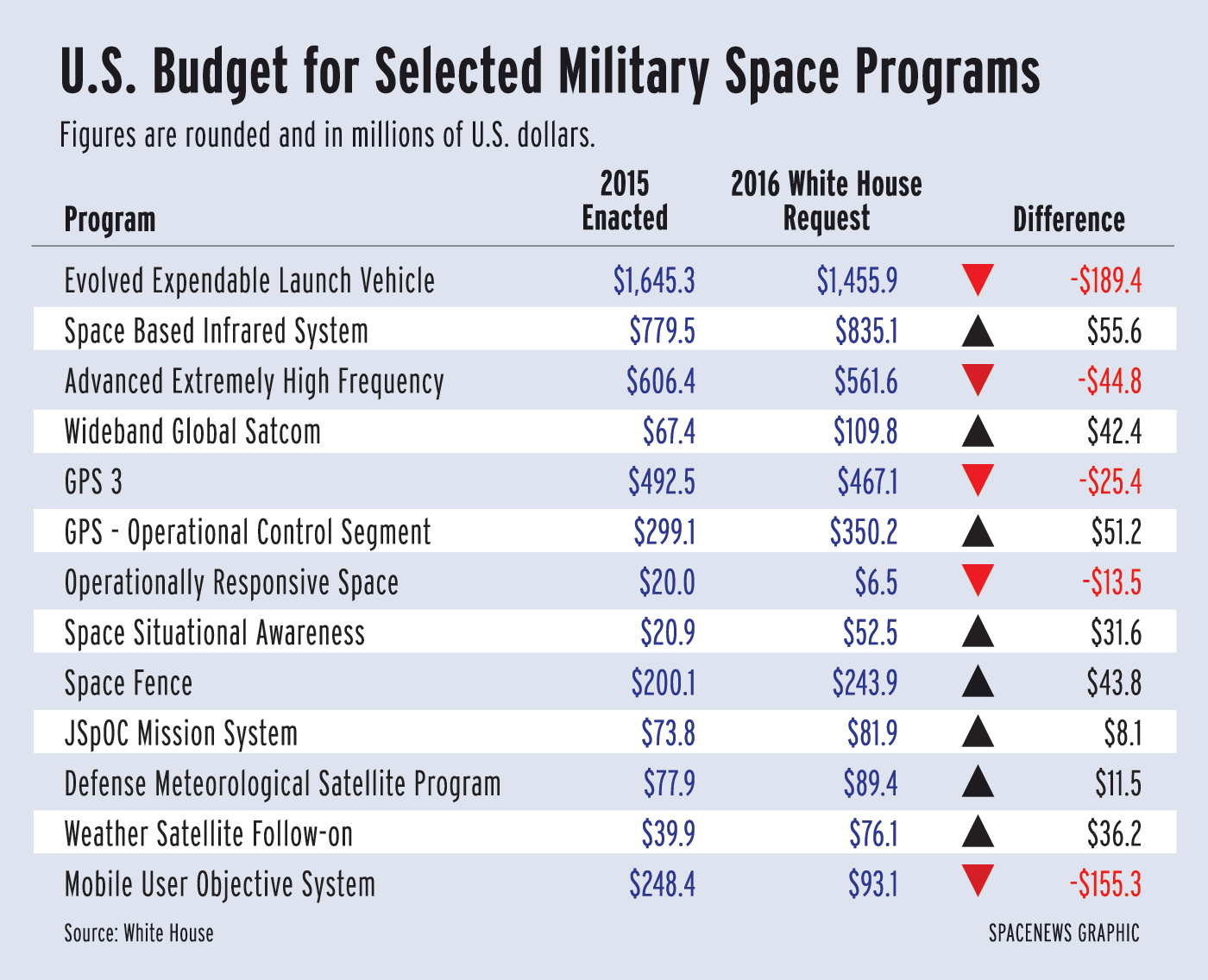
-
2017-04-16, 12:13 AM #99

Russia is very close to the Northwest Passage, they might even have a historical claim to it..
"This will be a fight against overwhelming odds from which survival cannot be expected. We will do what damage we can."
-- Capt. Copeland
-
2017-04-16, 12:22 AM #100
Self-appointed?! Are you fucking kidding me?! When that whole shit with Libya started it was Europe urging us and bitching at us to do something because it was in their interest to have Libya be more stable. When this shit with the children happened, again it was Europe urging us to step in. Whenever some shit happens in some place in the world we are urged to do something and then called world police at the same time.
"America save us!!!" "You fucking world police GTFO!"

 Recent Blue Posts
Recent Blue Posts
 Recent Forum Posts
Recent Forum Posts
 Should money be account-wide?
Should money be account-wide? MMO-Champion
MMO-Champion




 Reply With Quote
Reply With Quote



